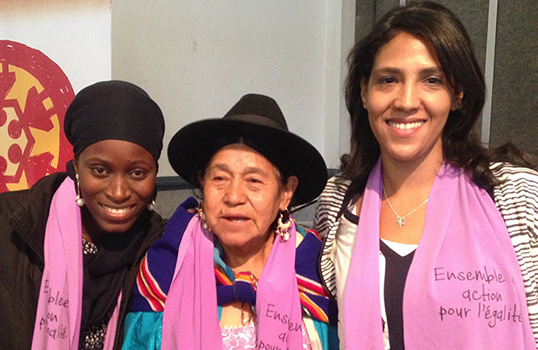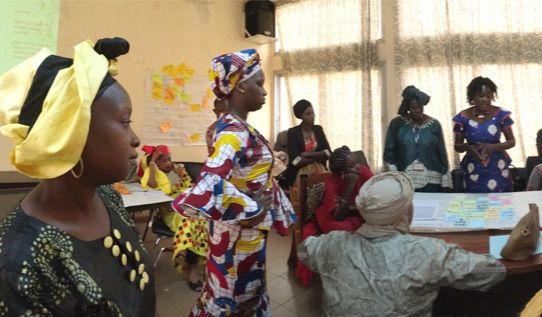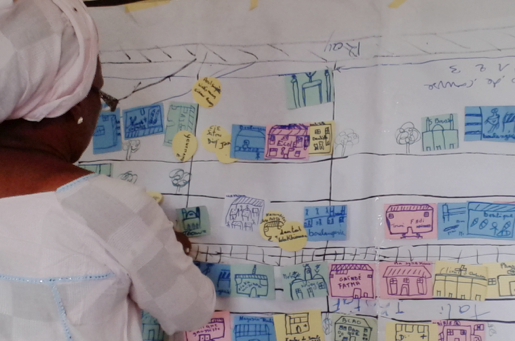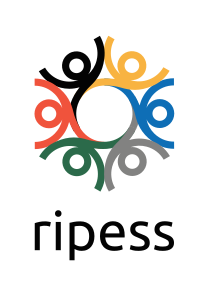On this International Women’s Day on March 8, the RIPESS “Women and SSE” Working Group, in collaboration with Quartiers du Monde, publishes this article on how the gender perspective can question and transform power relations within the SSE.
A social and solidarity-based economic activity does not de facto challenge gender-dominance relationships. The fact that an economic activity is carried out by a woman or a group of women does not systematically mean that the power relations of domination and subordination between men and women, and between women themselves, are called into question.
Social Solidarity Economy (SSE) must contribute to the emergence of a development model based on the values of equity, justice, transparency and solidarity, yet even if women represent more than 70 to 80% of the SSE workforce, both as founders of companies, administrators, employees and beneficiaries, equality between women and men is not achieved, particularly in terms of governance, pay equity, diversity of choice and access to economic and political resources.
SSE (as a process that brings a community together around an economic activity) promotes values of solidarity, but does not question the power relations between women and men, remains blind to the different realities, needs, desires and obligations of women and men.
Already in the early 2000s, feminist critics criticized the dominant vision of SSE for invoking reasons of effectiveness to accept more pragmatic strategies, which give more importance to the economic dimension than to the social purpose in the design and development of initiatives, thus giving priority to initiatives of an entrepreneurial nature. They were already questioning the capacity of the SSE to develop quality jobs for women.

Other more severe critics were concerned not only that there was little concern for the recognition of women’s work, but that SSE would lead to “a sharing of poverty rather than a sharing of wealth”. Many women in the field and researchers argued that the institutionalization process would secondarize women’s perceptions of the economy and strip the project of its transformative potential. Finally, many concluded that SSE was a step back for the women’s movement and undertook a defensive withdrawal to avoid greater economic insecurity for women and women’s groups.
For the majority of women involved in the debate, it was not a question of clapping the post of the consultation and structuring bodies, but of occupying more and better the field and possibly in a more contested way, in order to defend women’s interests and obtain recognition for their paid or unpaid work.
Integrating the gender perspective into SSE processes as a methodology allows us to question and transform the relationships of domination/power, as well as the inequalities built into the dominant economic model (patriarchal and capitalist), reproduced and reinforced in the world of work. Thus, integrating the gender perspective into SSE makes it possible to understand the mechanisms of patriarchy and their impact in the daily lives of women and men without proposing new assumptions, integrating gender perspective into SSE helps to remove the obstacles that women face in their socio-economic empowerment process.

SSE without gender perspective not only does not seek to deconstruct existing gender inequalities but also ignores many of the components that structure and reproduce the patriarchal system: the sexual division of governance and labor, violence against women, hegemonic masculinities etc., while the main mechanism of patriarchy is to establish power and domination relationships between women and men, between women and men.
For the creation/consolidation of social and solidarity entrepreneurial initiatives with gender perspective that empower women, it is important to have appropriate tools that make it possible to question the situation (and facilitate analysis) of women in all areas (training/instruction, health, family life, support for the environment, organization…) and the different spaces (private and public) of their lives; as well as technical support.
Integrating gender perspective into the support for social and solidarity-based entrepreneurship requires a global strategy that is implemented through concrete mechanisms located both in the functioning of the company and in its political positioning (in its socio-economic context) in order to ensure the places of women and men, their socio-economic empowerment and their equitable development within the company.

The Women of the World entities also stated that the challenge of SSE with gender perspective was to analyze gender hierarchies and inequalities, in order to recognize and make visible the tasks of protection and care assumed by women, tasks that are essential to the needs of their families, societies and capital.
If we want women’s SSE initiatives to be real vectors of emancipation, certain conditions must be met:
- Full recognition of women’s contribution to social and economic development while remaining sensitive to relevant differences in the status of women.
- raising awareness among the community, intermediaries developing SSE initiatives, SSE networks, SSE partners and investors of the importance of documenting and communicating the differential effects encountered by women and men in SSE in order to promote the adjustment of practices.
- the implementation of an inventory and in-depth studies on the place of women in the SSE (with gender-specific data, qualitative data, etc.) as well as the implementation of impact monitoring tools integrating GP.
- the implementation of “affirmative action” measures for women-led SSE initiatives (concerning funding mechanisms, appropriate support mechanisms, etc.).
- the abolition of the sexual division of labor, the recognition of women’s invisible work and the disappearance of job ghettos.
- full and equal participation in places of power and development.
- the implementation of proactive policies in terms of gender equality (on parity, equal pay, careers, social time, etc.) in SSE structures, through the training of its actors, incentive policies, etc..
- raising awareness against gender stereotypes and discriminatory practices in the different SSE areas.
- the strengthening of the gender perspective in the advocacy and agenda of SSE actors.
- the tool to fight poverty and exclusion while meeting the needs of women who are not met by the market economy.
The network’s agreements currently concern the implementation of transformative activities that make it possible to advance towards an objective of social justice, through training spaces, networking, and the equitable sharing of the power and wealth of collectives. Emphasis is also placed on vigilance against violence and attitudes of gender domination, whatever their forms, as well as on the fair and balanced distribution of tasks (including reproductive tasks) between members, women and men.
Integrating gender perspective into SSE aims to transform the perception, action and impact of this model on women’s lives, to question and transform power relations between men and women and between women, to make their economic initiatives a space of empowerment to strengthen their power to act. The network’s challenge is to transform the power relations and roles assigned by patriarchy to women and men, to adapt an economic sector that recognizes women and enhances their work.
SSE with gender perspective is a working methodology that integrates gender equality issues into SSE values and practices at all stages of the creation of an SSE activity. It maintains the desire to break with capitalism of the principles of the SSE and brings to it reflections and concepts of the feminist economy.
Written by the “Women and SSE” working group of RIPESS and Quartiers du Monde.



[…] It is therefore essential to reflect on how to build other ways of doing business, based on the thinking of women involved in Social Solidarity Economy (SSE) companies. Thus, this guide was created on the basis of the South-South-North network program “Women of the World: A Network of Women Entrepreneurs in Solidarity” and is based on two pillars: SSE and the gender perspective (GP). This orientation is intended to respond to the observation that the registration of an activity in the SSE field is not sufficient to promote equality between women and men despite the values established within the SSE. […]